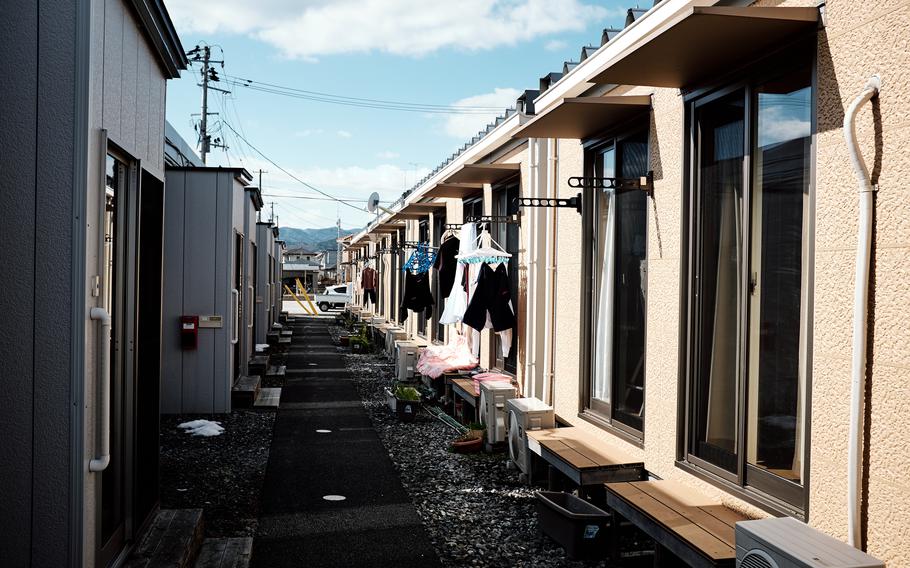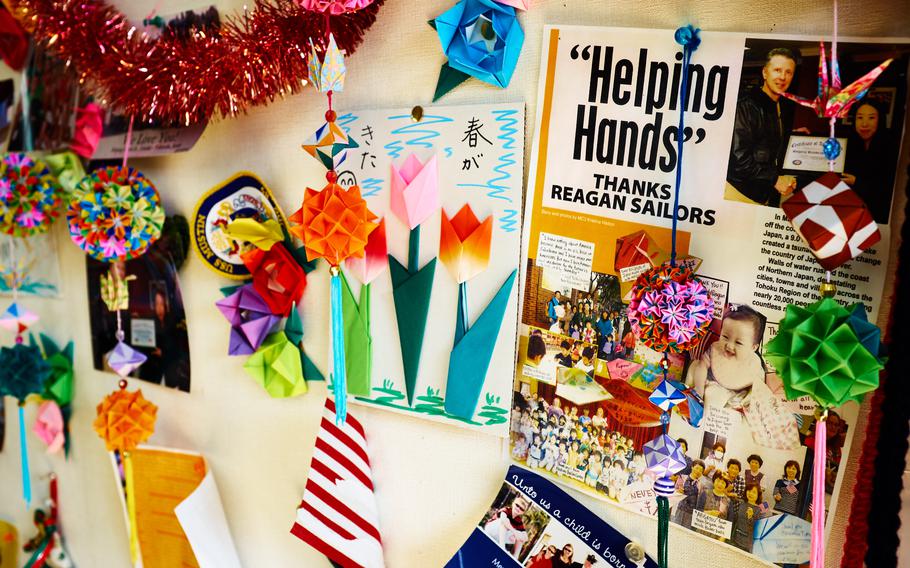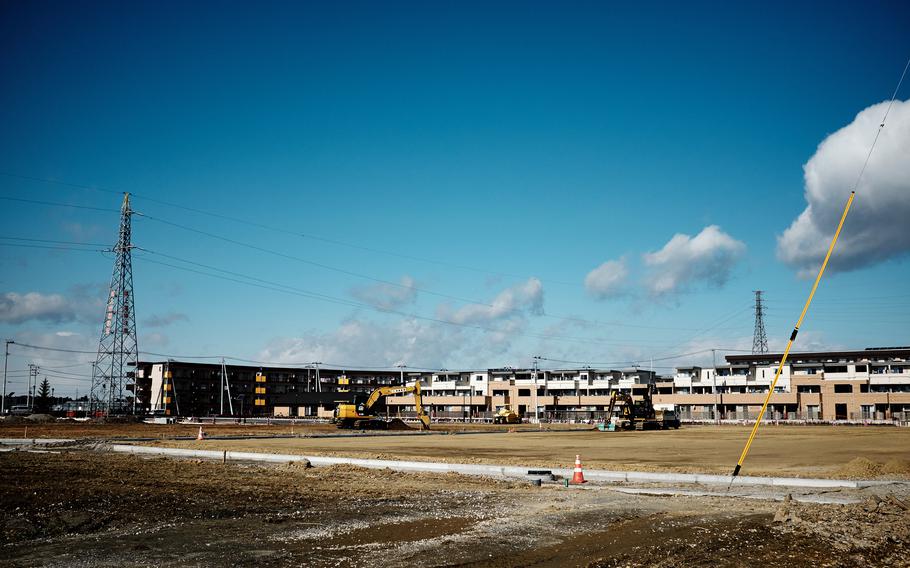.jpg/alternates/LANDSCAPE_910/xxQUAKE-HOUSINGphoto03%2054475667.jpg)
An intricate origami gift hangs on the wall in the Terauchi Daini temporary housing complex community room Feb. 11, 2016, in Minamisoma, Japan. The housing area’s residents give these gifts to visitors and volunteers, many of whom come from U.S. military bases in Japan. (James Kimber/Stars and Stripes)
This article first appeared in the Stars and Stripes Pacific edition, March 11, 2016. It is republished unedited in its original form.
MINAMISOMA, Japan — Take papers dyed in springtime colors, fold them into dozens of flower shapes and sew them into a single ball.
Add an origami crane, a smaller flower ball for visual balance and string it all together, ending with a tassel. Repeat.
The resulting decorations are how people who lost their homes to a March 11, 2011, tsunami and a nuclear meltdown — people still waiting to move into permanent homes after five years — have raised money to help others in need.
“We are happy to be helpful, even a little,” said Reiko Suzuki, 61, a resident of the Terauchi No. 2 temporary housing complex about 25 miles from the failed Fukushima Dai-ichi nuclear power plant.
Suzuki, like most of the other residents, lost her home to the tsunami and couldn’t rebuild after her neighborhood became part of the exclusion zone surrounding the power plant. The residents here live in prefabricated, 320-square-foot homes originally designed to last two years.

Temporary housing units in Terauchi Daini housing complex in Minamisoma, Japan, still house evacuees of the 2011 tsunami that hit northern Japan. The housing was only supposed to be used for three years, but sufficient permanent public housing remains years away from completion. (James Kimber/Stars and Stripes)
A displaced life is difficult by most accounts, and often not a healthy one.
A recent Fukushima University study found that Fukushima Prefecture residents suffered from psychological distress and maladies related to lifestyle changes at well above the national averages.
However, even amid hardship, communities form and relationships among neighbors grow.
The friendship that residents never expected came months after the disaster, when a Navy spouse named Masako Sullivan asked every Terauchi resident what they needed.
Shortly after, Sullivan and Helping Hands For Tohoku, an unofficial spouses group, began delivering rice, water, toiletries, clothing and other basic needs.
Even though most of the families who were here in 2011 have moved on to different duty stations, they never stopped supporting the Terauchi No. 2 residents. They passed word to incoming families and continued making the drive, about five hours from Yokosuka, to visit with them.

The wall at the Terauchi Daini temporary housing complex community room in Minamisoma, Japan, is covered with encouraging letters and thank-you notes, Feb. 11, 2016. Many of the visitors and volunteers come from U.S. military bases in Japan. (James Kimber/Stars and Stripes)
Spouses with Helping Hands and the Yokosuka Chiefs Spouses Association send the residents some of the materials they need to make the decorations. The residents then sent the finished products to Sullivan, who auctions them in San Diego.
That money has aided Helping Hands’ efforts to aid disaster victims in the Philippines, and to help buy holiday presents for military children who have lost a parent.
The money has also aided Japan’s recovery, along with other fundraising efforts in San Diego. They helped a day care center in Ishinomaki, a city that lost 3,500 people in the tsunami, after the center exhausted most of its funds rebuilding in a safer area.
“Donations kept coming, and we were able to build fences, purchase playground toys … in a few months the center got a very nice playground,” Sullivan said. “It was amazing teamwork.”
Pictures of Sullivan and the Terauchi No. 2 residents, along with postcards and baby pictures from other Navy families, hang in the housing complex’s community room.
They are reminders of the better times spent here — and a reminder of how many people no longer live here.
Perhaps that is the best thing that can be said about Terauchi No. 2: it is only about half-occupied. The remaining residents are among 60,784 people still living in prefabricated housing as of January, according to government figures.
When Stars and Stripes visited in 2014, the complex was still full, and residents spoke about the strain and stress of uncertainty.

Public housing units are among the largest reconstruction efforts in Ishinomaki, Japan, as seen Feb. 10, 2016. (James Kimber/Stars and Stripes)
That hasn’t gone away entirely, but there is also noticeably more hope amid plans for something more permanent.
Takeko Aihara, 84, can’t return to her old home in Minamisoma’s Kaibama area, where 80 people out of a community of 70 households died during the tsunami. Her family may join some of the survivors, who have clustered together in a new community, but the choice isn’t so simple.
“My grandchild doesn’t want to live where the ocean can be seen,” Aihara said.
Suzuki should be able to return to their old neighborhood when the government certifies the area as decontaminated in April.
Her family is on a waiting list to repair their home and may be able to move out by the end of the year.
However, her mother-in-law requires special care, and they’ll need a medical facility to move into the area before they do, which isn’t a given.
Despite all of the troubles they’ve endured, five years in temporary housing made them like a family, said several of the women who gathered along with Suzuki to talk with Stars and Stripes.
When they leave Terauchi No. 2, they’ll likely have to keep in touch by phone, since so many are elderly and can’t drive.
“It will be lonely,” Suzuki said. “But we have to move forward.”
Stars and Stripes reporter Hana Kusumoto contributed to this report.